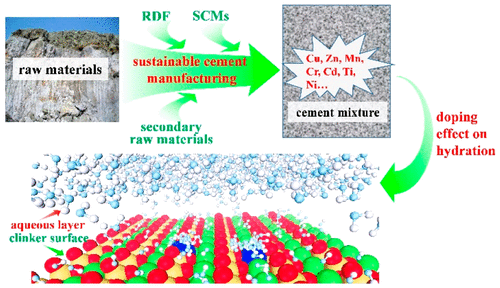当前位置:
X-MOL 学术
›
ACS Sustain. Chem. Eng.
›
论文详情
Our official English website, www.x-mol.net, welcomes your
feedback! (Note: you will need to create a separate account there.)
Predicting Hydration Reactivity of Cu-Doped Clinker Crystals by Capturing Electronic Structure Modification
ACS Sustainable Chemistry & Engineering ( IF 7.1 ) Pub Date : 2019-02-25 00:00:00 , DOI: 10.1021/acssuschemeng.9b00327 Yong Tao , Wenqin Zhang , Neng Li , Fazhou Wang , Shuguang Hu
ACS Sustainable Chemistry & Engineering ( IF 7.1 ) Pub Date : 2019-02-25 00:00:00 , DOI: 10.1021/acssuschemeng.9b00327 Yong Tao , Wenqin Zhang , Neng Li , Fazhou Wang , Shuguang Hu

|
Chemical doping is a promising scheme for sustainable development of green and economical cement manufacturing related to global energy and environmental concerns. Understanding and controlling doping effect on reactive cement components is the prerequisite. This study aims to propose effective theoretical methods to reveal the correlation between hydration reactivity of doped clinker crystals and their electronic structures. Four dominant Portland cement clinker phases with copper doping are comparatively investigated by the state-of-the-art ab initio calculation. It finds that Cu ions doped in silicate and aluminate phases shift the nucleophilic reactive sites from Ca-centered regions to defect sites by decreasing the effective charges of Ca ions, which accounts for the hydration retardation of these phases. Exceptionally, the reactive sites in ferrite phase are scarcely changed by Cu doping due to the intense band-edge localization of Fe 3d state, which implies the relatively lesser influence on hydration reactivity. The corresponding experiments of the ion release rate of clinker phases during early hydration process as captured by the conductivity meter and inductively coupled plasma-optical emission spectrum strongly support our computational results. Our theoretical calculations provide a powerful method to predict the early hydration reactivity of clinker minerals and enrich the understanding of early hydration characteristics and its variations.
中文翻译:

通过捕获电子结构修饰预测铜掺杂的熟料晶体的水化反应性
化学掺杂是与全球能源和环境问题相关的绿色和经济型水泥生产可持续发展的有前途的计划。了解和控制对活性水泥成分的掺杂效果是前提。本研究旨在提出有效的理论方法,以揭示掺杂熟料晶体的水合反应性与其电子结构之间的相关性。通过最先进的从头算计算,对比研究了四个掺杂铜的波特兰水泥熟料相。发现掺杂在硅酸盐和铝酸盐相中的Cu离子通过减少Ca离子的有效电荷将亲核反应性位点从Ca中心区域转移到缺陷位点,这解释了这些相的水合延迟。非常好 Fe 3d态的强能带边局限性使得Cu掺杂几乎不会改变铁素体相中的反应位,这对水合反应性的影响相对较小。电导率仪和电感耦合等离子体-光发射光谱捕获的水合过程早期熟料相的离子释放速率的相应实验有力地支持了我们的计算结果。我们的理论计算为预测熟料矿物的早期水合反应性和丰富对早期水合特性及其变化的理解提供了有力的方法。电导率仪和电感耦合等离子体-光发射光谱捕获的水合过程早期熟料相的离子释放速率的相应实验有力地支持了我们的计算结果。我们的理论计算为预测熟料矿物的早期水合反应性和丰富对早期水合特性及其变化的理解提供了有力的方法。电导仪和电感耦合等离子体-光发射光谱捕获的水合过程早期熟料相的离子释放速率的相应实验有力地支持了我们的计算结果。我们的理论计算为预测熟料矿物的早期水合反应性和丰富对早期水合特性及其变化的理解提供了有力的方法。
更新日期:2019-02-25
中文翻译:

通过捕获电子结构修饰预测铜掺杂的熟料晶体的水化反应性
化学掺杂是与全球能源和环境问题相关的绿色和经济型水泥生产可持续发展的有前途的计划。了解和控制对活性水泥成分的掺杂效果是前提。本研究旨在提出有效的理论方法,以揭示掺杂熟料晶体的水合反应性与其电子结构之间的相关性。通过最先进的从头算计算,对比研究了四个掺杂铜的波特兰水泥熟料相。发现掺杂在硅酸盐和铝酸盐相中的Cu离子通过减少Ca离子的有效电荷将亲核反应性位点从Ca中心区域转移到缺陷位点,这解释了这些相的水合延迟。非常好 Fe 3d态的强能带边局限性使得Cu掺杂几乎不会改变铁素体相中的反应位,这对水合反应性的影响相对较小。电导率仪和电感耦合等离子体-光发射光谱捕获的水合过程早期熟料相的离子释放速率的相应实验有力地支持了我们的计算结果。我们的理论计算为预测熟料矿物的早期水合反应性和丰富对早期水合特性及其变化的理解提供了有力的方法。电导率仪和电感耦合等离子体-光发射光谱捕获的水合过程早期熟料相的离子释放速率的相应实验有力地支持了我们的计算结果。我们的理论计算为预测熟料矿物的早期水合反应性和丰富对早期水合特性及其变化的理解提供了有力的方法。电导仪和电感耦合等离子体-光发射光谱捕获的水合过程早期熟料相的离子释放速率的相应实验有力地支持了我们的计算结果。我们的理论计算为预测熟料矿物的早期水合反应性和丰富对早期水合特性及其变化的理解提供了有力的方法。















































 京公网安备 11010802027423号
京公网安备 11010802027423号